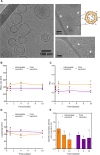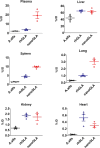Targeted nanoliposomes to improve enzyme replacement therapy of Fabry disease
- PMID: 39671483
- PMCID: PMC11801267
- DOI: 10.1126/sciadv.adq4738
Targeted nanoliposomes to improve enzyme replacement therapy of Fabry disease
Abstract
The central nervous system represents a major target tissue for therapeutic approach of numerous lysosomal storage disorders. Fabry disease arises from the lack or dysfunction of the lysosomal alpha-galactosidase A (GLA) enzyme, resulting in substrate accumulation and multisystemic clinical manifestations. Current enzyme replacement therapies (ERTs) face limited effectiveness due to poor enzyme biodistribution in target tissues and inability to reach the brain. We present an innovative drug delivery strategy centered on a peptide-targeted nanoliposomal formulation, designated as nanoGLA, engineered to selectively deliver a recombinant human GLA (rhGLA) to target tissues. In a Fabry mouse model, nanoGLA demonstrated improved efficacy, inducing a notable reduction in Gb3 deposits in contrast to non-nanoformulated GLA, even in the brain, highlighting the potential of the nanoGLA to address both systemic and cerebrovascular manifestations of Fabry disease. The EMA has granted the Orphan Drug Designation to this product, underscoring the potential clinical superiority of nanoGLA over authorized ERTs and encouraging to advance it toward clinical translation.
Figures







References
-
- Zarate Y. A., Hopkin R. J., Fabry’s disease. Lancet 372, 1427–1435 (2008). - PubMed
-
- Carnicer-Cáceres C., Arranz-Amo J. A., Cea-Arestin C., Camprodon-Gomez M., Moreno-Martinez D., Lucas-Del-pozo S., Moltó-Abad M., Tigri-Santiña A., Agraz-Pamplona I., Rodriguez-Palomares J. F., Hernández-Vara J., Armengol-Bellapart M., Del-Toro-riera M., Pintos-Morell G., Biomarkers in fabry disease. Implications for clinical diagnosis and follow-up. J. Clin. Med. 10, 1664 (2021). - PMC - PubMed
-
- Bodary P. F., Shayman J. A., Eitzman D. T., α-Galactosidase A in Vascular Disease. Trends Cardiovasc. Med. 17, 129–133 (2007). - PubMed
MeSH terms
Substances
LinkOut - more resources
Full Text Sources
Medical
Molecular Biology Databases
Research Materials

